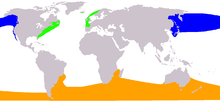Right whale
| Right whales | |
|---|---|
 |
|
| Southern right whale breaching | |
 |
|
| Size compared to an average human | |
| Scientific classification | |
| Kingdom: | Animalia |
| Phylum: | Chordata |
| Class: | Mammalia |
| Order: | Artiodactyla |
| Infraorder: | Cetacea |
| Family: | Balaenidae |
| Genus: |
Eubalaena Gray, 1864 |
| Type species | |
|
Balaena australis Desmoulins, 1822 |
|
| Species | |
|
|
 |
|
|
Ranges Eubalaena glacialis
Ranges Eubalaena australis
Ranges Eubalaena japonica
|
|
| Synonyms | |
|
|
Right whales are three species of large baleen whales of the genus Eubalaena: the North Atlantic right whale (E. glacialis), the North Pacific right whale (E. japonica) and the Southern right whale (E. australis). They are classified in the family Balaenidae with the bowhead whale. Right whales have rotund bodies with arching rostrums, V-shaped blowholes and dark gray or black skin. The most distinguishing feature of a right whale is the rough patches of skin on its head which appear white due to parasitism by whale lice. Right whales can grow up to more than 18 m (59 ft) long with the maximum record of 19.8 m (65 ft) and weigh up to 100 short tons (91 t; 89 long tons) or more; 20.7 m (68 ft) with 135,000 kg (298,000 lb) or 21.3 m (70 ft) with uncertainty, being significantly larger than other coastal species such as humpbacks, grays, or eden's and omura's, but smaller than blues. One (apocryphal) explanation for their name is that right whales were named by whalers who identified them as the "right" whale to kill on a hunt due to the plentiful oil and baleen they could provide.
All three species are migratory, moving seasonally to feed or give birth. The warm equatorial waters form a barrier that isolates the northern and southern species from one another although at least the southern species have been known to cross the equator. In the Northern Hemisphere, right whales tend to avoid open waters and stay close to peninsulas and bays and on continental shelves, as these areas offer greater shelter and an abundance of their preferred foods. In the Southern Hemisphere, right whales feed far offshore in summer, but a large portion of the population occur in near shore waters in winter. Right whales feed mainly on copepods but also consume krill and pteropods. They may forage the surface, underwater or even on the ocean bottom. During courtship, males gather into large groups to compete for a single female, suggesting that sperm competition appears to be an important factor in mating behavior. Although the blue whale is the largest animal on the planet, the testes of the right whale are actually ten times larger than those of the blue whale – with each weighing up to 525 kilograms (1,157 lb), they are by far the largest of any animal on Earth. Gestation tends to last a year, and calves are born at 1 short ton (0.91 t; 0.89 long tons) in weight and 4–6 m (13–20 ft) in length. Weaning occurs after eight months.
...
Wikipedia
